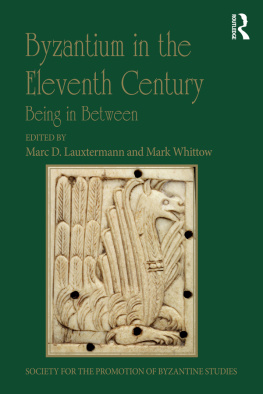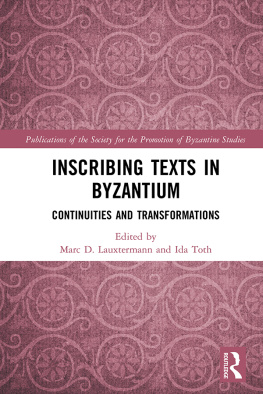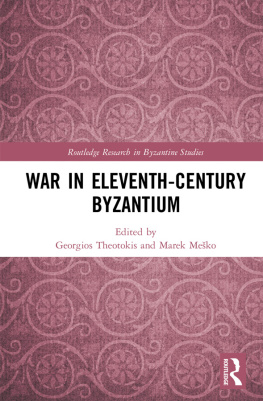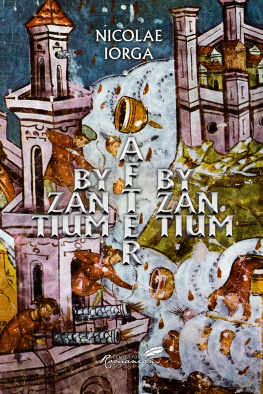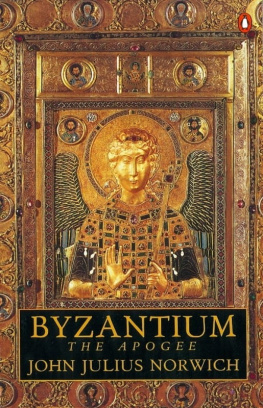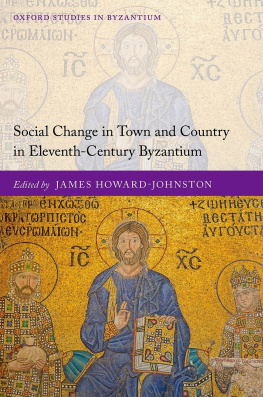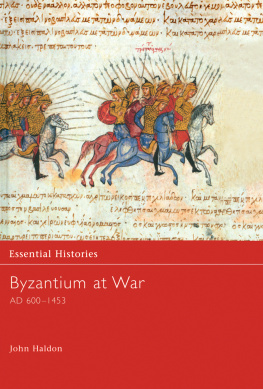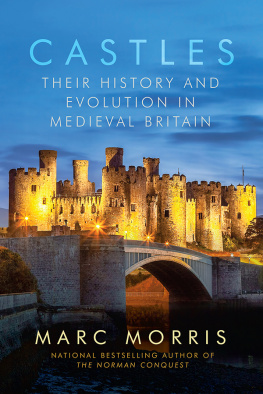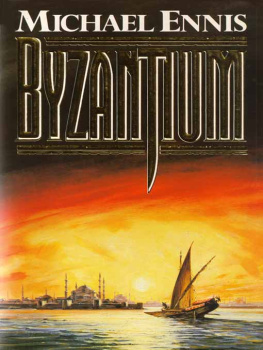Marc D. Lauxtermann - Byzantium in the Eleventh Century
Here you can read online Marc D. Lauxtermann - Byzantium in the Eleventh Century full text of the book (entire story) in english for free. Download pdf and epub, get meaning, cover and reviews about this ebook. year: 2017, publisher: Taylor & Francis (CAM), genre: Detective and thriller. Description of the work, (preface) as well as reviews are available. Best literature library LitArk.com created for fans of good reading and offers a wide selection of genres:
Romance novel
Science fiction
Adventure
Detective
Science
History
Home and family
Prose
Art
Politics
Computer
Non-fiction
Religion
Business
Children
Humor
Choose a favorite category and find really read worthwhile books. Enjoy immersion in the world of imagination, feel the emotions of the characters or learn something new for yourself, make an fascinating discovery.
- Book:Byzantium in the Eleventh Century
- Author:
- Publisher:Taylor & Francis (CAM)
- Genre:
- Year:2017
- Rating:5 / 5
- Favourites:Add to favourites
- Your mark:
- 100
- 1
- 2
- 3
- 4
- 5
Byzantium in the Eleventh Century: summary, description and annotation
We offer to read an annotation, description, summary or preface (depends on what the author of the book "Byzantium in the Eleventh Century" wrote himself). If you haven't found the necessary information about the book — write in the comments, we will try to find it.
Byzantium in the Eleventh Century — read online for free the complete book (whole text) full work
Below is the text of the book, divided by pages. System saving the place of the last page read, allows you to conveniently read the book "Byzantium in the Eleventh Century" online for free, without having to search again every time where you left off. Put a bookmark, and you can go to the page where you finished reading at any time.
Font size:
Interval:
Bookmark:
The 45th Spring Symposium of Byzantine Studies was held in Exeter College, Oxford on 246 March 2012, three remarkably warm days for the season, the second of which not only happened to coincide with the liturgical feast of the Annunciation, but also saw a blockade of Exeter College by LGBT activists. Reason enough, one would say, to enjoy the lovely weather and the idyllic surroundings of Oxford. And yet they came in droves, from nearby and further afield, ostensibly to listen to talks on Byzantium in the eleventh century, but also, even though they may not have realized it, to explore in-betweenness (its a word, look it up). There was a record number of 52 speakers (23 lectures and 29 short communications) and 150 participants, for which we are immensely grateful. All this would not have been possible without the kind and generous support of the A.G. Leventis Foundation, the Oxford Centre for Byzantine Research, the Interfaculty Committee for Late Antique and Byzantine Studies, the Faculty of Medieval and Modern Languages and the History Faculty. We are also most grateful to the staff of Exeter College and our two energetic student assistants, Prerona Prasad and Eleni Karafotia.
From Encyclopaedism to Humanism
Paul Magdalino
Since the 1970s, the eleventh century has been central to the critique of the concept of an unchanging Byzantium, a critique that has become almost as much of a clich as the dead horse that it continues to flog. The 45th Spring Symposium did not buck the trend; in its introductory blurb, and in placing Michael Psellos at the top of its agenda, it clearly signalled change, rather than continuity, as the salient characteristic of the period. Nor does the present chapter go against the flow; on the contrary, I wish to strengthen and clarify the paradigm that we owe to Lemerle and Kazhdan of the eleventh century as a period of change in Byzantine culture. Here I would like to go deeper and look at the dynamics of the process. I would like to suggest that the eleventh century was not just a period during which changes occurred, but that it began with a significant transition, a flip of the switch that differentiated the Byzantium that went before from the Byzantium that came after. Crudely speaking, Byzantine elite culture passed from an age of classicism and encyclopaedism to an age of humanism and Hellenism, from which it never looked back.
This moment of cultural change is easy to miss, or to dismiss, because it occurred within a framework of strong institutional and ideological continuity. A particularly eloquent example from our period is the monastery of Stoudios.
All these graduates of the Stoudios were, in their different ways, exponents of Orthodoxy, and Orthodoxy, or more precisely the culture of Orthodoxy, was the main thing they had in common with the rest of the educated elite who staffed the institutions of church and state past, present and future. In my work on the twelfth century, I entitled my chapter on intellectual culture the guardians of Orthodoxy, The culture of Orthodoxy was a continuum that spanned the centuries from the end of iconoclasm to the end of Byzantium.
But if the culture of Orthodoxy the imperative of right thinking, the importance of being Orthodox did not waver, becoming, if anything, more rigid with time, the Orthodoxy of culture the definition and content of right thinking became increasingly flexible, diverse and inclusive of contradictions.
Instead of returning to these developments, which have been well studied and are well known, I would like to pick out one smaller thread that perfectly illustrates the widening gap between the culture of Orthodoxy and the Orthodoxy of culture. This is the changing emphasis in the image of St Gregory of Nazianzos, surnamed the Theologian, who was the Orthodox Church Father par excellence. So Psellos effectively constructs the Theologian as a role model and a justification for his own intellectual priorities.
Yet Psellos was not the only or the first Byzantine intellectual to adopt the Theologian as an exemplar of qualities other than his Orthodox theology. Psellos contemporary John Mauropous was clearly inspired by Gregorys example in writing autobiographical poetry, and in justifying his resignation from his bishopric.
As we shall see, Sikeliotes used the example of Gregory of Nazianzos to formulate an ideology of politikos logos , thus inaugurating the revival of the Second Sophistic that culminated in what has recently been characterized as the civic humanism of the late Byzantine city. Justinian and Romanos the Melodist would not have approved.
These new expressions of creative and critical thinking in classical mode coincide with the end of the so-called encyclopaedism of the tenth century, whose final projects date from the last quarter of the century and the very first years of the eleventh: the Metaphrastic Menologion,
It is clear that during the age of encyclopaedism, Byzantine graduates were fully committed to working for the ideology of the imperial theocracy, whether in serving as bishops and civil servants, or in delivering occasional rhetoric, or in contributing to one encyclopaedic project or another. But it is also clear that as encyclopaedism petered out in the late tenth century, while they continued to write for the institutions that employed them, they increasingly set their own intellectual agenda, and used their intellectual skills not just to Atticize the image of the emperor and the saints, but also to entertain each other and establish a climate of complicity as well as competition with their peers. The medium was becoming the message. We can see this happening in the writings of Leo the Deacon, Leo of Synada, John Geometres and John Sikeliotes. The question is now, why did it happen when it did?
Part of the answer is implicit in the process of cultural evolution defined by Kazhdan But palace schools had existed before, and had come and gone without any measurable effect. In addition to the process of natural evolution, we should pay attention to important events that occurred around the turn of the millennium.
One, which was as important as its effects are intangible, was the millennium itself: the arrival of the significant anniversaries of Christs Incarnation and Ascension, which in the Byzantine calendar fell in 992 and 1026 respectively.
It is significant that all these anticipations of doomsday are expressed in texts without any pretensions to classical knowledge or eloquence. This does not mean that learned men were oblivious to doomsday. The preface of Leo the Deacons history proves otherwise, but it also shows that Attic discourse was not the right medium for writing about the end of the world. According to Leo, writing around the year 1000, it seemed to many of his contemporaries that the extraordinary upheavals of his lifetime frightful portents in the heaven, unbelievable earthquakes, thunderbolts, torrential rains, wars, troop movements, mass migrations were signs that the Second Coming was at hand. He decided to write about them so that they would not be forgotten in case Providence had decreed otherwise. So classicizing historiography was the medium for writing about events that did not prove to be the end of the world. It was the medium by which learned men distanced themselves from the mood of apocalypse now, and from both the fears and the pious hopes that it engendered.
Leo the Deacon wrote his history for posterity, and also, no doubt, to be read by specific friends and colleagues. He did not write it for the reigning emperor, Basil II. In fact, very few people did write for Basil II, apparently because Basil II did not encourage it. This brings us to the other main factor that affected Byzantine intellectual life around the turn of the millennium: the lack of patronage. The encyclopaedic projects of the tenth century had been directed by two principal figures, the emperor Constantine VII and the quasi-imperial eunuch minister Basil the parakoimomenos , who had acquired wealth and dispensed patronage on an imperial scale from before 959 until 985, when Basil II sacked him.
Font size:
Interval:
Bookmark:
Similar books «Byzantium in the Eleventh Century»
Look at similar books to Byzantium in the Eleventh Century. We have selected literature similar in name and meaning in the hope of providing readers with more options to find new, interesting, not yet read works.
Discussion, reviews of the book Byzantium in the Eleventh Century and just readers' own opinions. Leave your comments, write what you think about the work, its meaning or the main characters. Specify what exactly you liked and what you didn't like, and why you think so.

